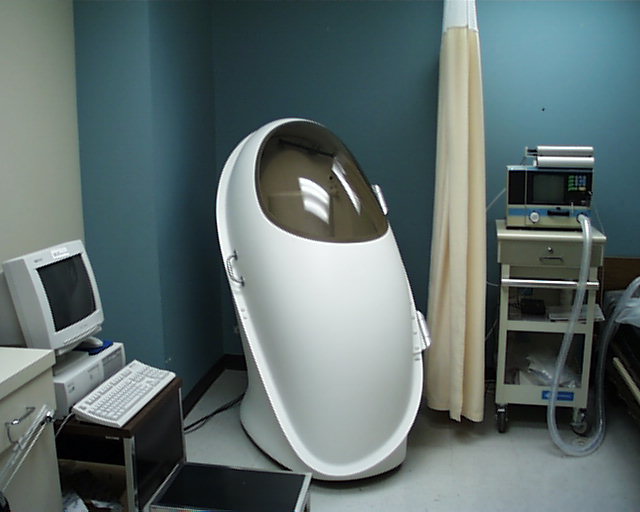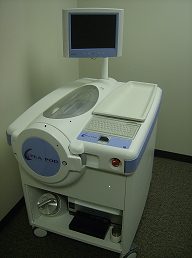Because diabetes is both a metabolic and a vascular disease, the Human Physiology Core was designed to promote interactions and collaborations oriented towards better understanding the pathophysiology of diabetes and cardiometabolic disease risk. To this end, the Human Physiology Core incorporates and combines expertise and technology for assessment of hormones and other analytes in both humans and animal models; body composition and fat distribution; insulin sensitivity and substrate metabolism; energy expenditure; and cardiovascular function. Assessments provided by the core are direct, sophisticated, state-of-the-art measures that utilize the most current technology available. Access to these services and technologies is designed to facilitate a sophisticated, multidisciplinary, and comprehensive approach to diabetes research and to provide common ground for collaboration and training.
Services
 BodPod for assessment of child and adult body volume and density. Serum analysis (clinical and animal models)
BodPod for assessment of child and adult body volume and density. Serum analysis (clinical and animal models)
- Hormones and markers of inflammation. A broad suite of metabolic and reproductive hormones; multiplex capabilities; markers of inflammation, adipokines, cytokines
- Glucose and lipids: Glucose, total cholesterol, HDL-cholesterol (HDL-C), LDL-C, triglycerides (TG), and total free fatty acids
Human Energy Expenditure/Substrate Metabolism
- Total energy expenditure by doubly-labeled water
- Resting energy expenditure by indirect calorimetry
- 24-h energy expenditure by whole-room indirect calorimetry
- Local heat production by infra-red camera
 The PeaPod can analyze body composition in infants aged 0-6 mo. Human Body Composition
The PeaPod can analyze body composition in infants aged 0-6 mo. Human Body Composition
- Dual-energy X-ray absorptiometry
- Body density by BodPod (Adult/child)
- Body density by PeaPod (Infant)
- Total body water by isotope dilution
- Multi-compartment models
- Bone quality by pQCT
- Fat distribution by portable ultrasound
- MRI/CT scan analysis
Human insulin sensitivity and glucose tolerance testing
- Euglycemic clamp
- Intravenous glucose tolerance test
- Oral glucose tolerance test
- Mixed meal tolerance test
- Mathematical modeling
Resources & Methods
Isotope Ratio Mass Spectrometer (IRMS): The Core is equipped with two IRMS (Optima and Delta-V) for measurement of enrichment of deuterium and oxygen-18 in biological samples. Stable isotope dilution and metabolism can be used to assess body composition and free-living energy expenditure.
Indirect Calorimetry (resting): Two open-circuit metabolic monitors are available for assessment of resting energy expenditure (REE) and substrate oxidation (fat, carbohydrate) (Vmax ENCORE 29N Systems, SensorMedics Corporation, Yorba Linda, CA).
Indirect Calorimetry (whole-room): Room indirect calorimetry is used for evaluation of 24-h energy metabolism. The calorimeter has a gross volume of 17,500 liters (3.4m long, 2.1m wide, and 2.6m high). It is equipped with a fold-out bed, desk, chair, refrigerator, toilet, sink, television, video player, telephone, and airlock for the passage of food and materials in and out of the room. Data can be collected for sleeping energy expenditure, resting energy expenditure, physical activity-related energy expenditure, and diet-induced thermogenesis. Activity is monitored by a short-range, precision microwave motion detector.
Infra-red camera: The FLIR T300 camera can be used to detect and quantify local heat production (e.g., hands, chest, abdomen).
Bod Pod: The BodPod (Life Measurement, Inc., Concord, CA) consists of a two-chamber plethysmograph for assessment of body volume and density in children and adults. The unit contains a pediatric insert that allows for determination of body composition in children aged ~7 mo and older. The test requires ~30 minutes.
PeaPod: The portable PeaPod® (LMI) consists of a two-chamber plethysmograph. Infant body volume and density are used to calculate body composition. The test requires ~30 minutes.
Dual-Energy X-ray Absorptiometry (DXA): The Core houses two iDXA instruments (GE-Lunar Radiation Corp. Madison, WI) for assessment of total and regional body composition. The new CoreScan software includes an estimate of visceral fat that is produced by subtracting measured subcutaneous abdominal fat from measured total abdominal fat. Bone density of the spine and hip also can be assessed. Whole-body scans require ~10-15 min. Additional hip or spine scans require re-positioning and re-scanning.
Magnetic Resonance Imaging (MRI): MRI scanning is conducted on clinical scanners in the Department of Radiology at UAB (Philips 1.5 Tesla Ingenia Omega HP). The Core provides scan analysis and assistance with making necessary contacts with personnel in Radiology.
Peripheral Quantitative Computed Tomography (pQCT): The XCT 3000® (Stratec, Germany) is a fully automated X-ray system for the determination of bone density and quality. The pQCT offers an alternative to computed tomography (CT) and MRI for investigators who do not wish to, or cannot accommodate, the time constraints, expense, subject burden, or radiation exposure associated with CT or MRI. Study participants insert either the distal forearm (radius) or the lower leg (tibia) into the instrument. Scan time differs per location, but is typically 3 min.
Portable ultrasound: The BodyMetrix is a hand-held instrument that can be used for assessing body composition and fat distribution locally. This instrument is particularly useful in populations for whom X-ray-based and/or imaging methods may be inappropriate or impractical (e.g., pregnant women, small children, individuals with disabilities).
Insulin sensitivity/glucose tolerance testing: The core can facilitate protocols for the euglycemic clamp, the intravenous glucose tolerance test, the oral glucose tolerance test, and the mixed meal tolerance test. All of these tests are conducted in the Clinical Research Unit (CRU) of UAB's Center for Clinical and Translational Research (CCTS). The CRU nurses are trained to conduct the tests, and sample processing is performed by the CCTS Processing Laboratory. Analyses of serum analytes (e.g., glucose, insulin) are conducted by the core. The core can assist with data reduction by mathematical modeling or by simple arithmetic approaches. The core director will provide consultation and expertise in identifying the most appropriate test and data analytical approach for each study.
Vascular Reactivity: Endothelial function as indexed by flow-mediated brachial artery dilatation (FMD). Changes in brachial artery diameter during reactive hyperemia are measured by high-resolution ultrasound. Pulse wave velocity and central aortic augmentation index are calculated using large artery applanation tonometry.
Impedance cardiography: as measured by thoracic electrical impedance using four dual sensors on neck and chest. Measures include cardiac output (CO), systemic vascular resistance (SVR), and thoracic fluid content (TFC).
Ambulatory blood pressure monitoring: Twenty-four hour blood pressure values are obtained with use of programmable ambulatory blood pressure monitors.
Publications
- Goss AM, Goree LLT, Ellis AC, Chandler-Laney PC, Casazza K, Lockhart M, Gower BA. 2013. Effects of diet macronutrient composition on body composition and fat distribution during weight maintenance and weight loss. Obesity, 21:1139-42.
- Hamilton K, Fisher G, Roy J, Gower BA, Hunter GR. 2013. The Effects of Weight Loss on Relative Bone Mineral Density in Premenopausal Women. Obesity 21:441-8.
- Goss AM, Gower BA. 2012. Insulin sensitivity is associated with thigh adipose tissue. Metabolism 61:1817-23
- Ellis AC, Hyatt TC, Hunter GR, Gower BA. 2010. Respiratory quotient predicts fat mass gain in premenopausal women. Obesity, 18:2255-2259. PMCID:PMC3075532
- Del Corral P, Chandler-Laney P, Casazza K, Gower BA, Hunter GR. 2009. Effect of dietary adherence with or without exercise on weight loss: a mechanistic approach to a global problem. J. Clin. Endo. Metab., 94:1602-1607. PMCID:PMC2684471
Personnel

Director: Barbara Gower, Ph.D.
Webb 616A
1675 University Blvd.
Birmingham, AL 35294
Phone: (205) 934-4087
Fax: (205) 934-7050
Email: bgower@uab.edu
